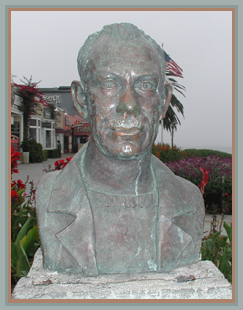John Steinbeck
(1902 - 1968)

Bust of John Steinbeck by C.W. Brown
on Cannery Row in Monterey, California
In 1962 John Steinbeck became the sixth American writer to win the
Nobel Prize for Literature. His Salinas, California birthplace and
nearby areas such as Monterey provide settings for many of his novels.

"Cannery Row in Monterey in California is a poem, a
stink, a grating noise, a quality
of light, a habit, a nostalgia, a dream. . . ." (John Steinbeck, Cannery Row, 1)
When presenting the Nobel Prize for Literature to John Steinbeck, Anders Österling of the Swedish Academy noted the made the following observations about the author's work:
There is in him a strain of grim humour which, to some extent, redeems his often cruel and crude motif. His sympathies always go out to the oppressed, to the misfits and the distressed; he likes to contrast the simple joy of life with the brutal and cynical craving for money. But in him we find the American temperament also in his great feeling for nature, for the tilled soil, the wasteland, the mountains, and the ocean coasts, all aninexhaustible source of inspiration to Steinbeck in the midst of, and beyond, the world of human beings.
Born in Salinas, California in 1902, Steinbeck was the son of a miller and a school teacher. Between 1919 and 1925 he studied literature and writing at Stanford University although he left without completing a degree. Then he moved to New York where he earned his living as a labourer and a journalist. In 1929, while working as a caretaker on a Lake Tahoe estate, Steinbeck completed his first novel Cup of Gold: A Life of Sir Henry Morgan, Buccaneer, With Occasional Reference to History, his only work of historical fiction. Although his subsequent novels frequently portrayed the struggles the American working class, his writing, including that generated by his work as a journalist, covers a wide range of topics including marine biology, the Second World War, his own life and American society. His works include the following:
Cup of Gold: A Life of Sir Henry Morgan, Buccaneer, With Occasional Reference to History (1929)
The Pastures of Heaven (1932)
To a God Unknown (1933)
Tortilla Flat (1935)
In Dubious Battle (1936)
Of Mice and Men (1937)
The Long Valley - Short Stories (1938)
The Grapes of Wrath (1939)
The Forgotten Village:Life In A Mexican Village : With 136 photgraphs From the Film of the Same Name (1941)
The Sea of Cortez (1941)
Bombs Away: The Story of a Bomber Team (1942)
The Moon is Down (1942)
Cannery Row (1945)
The Red Pony (first published in 1937; expanded in 1945)
The Wayward Bus (1947)
The Pearl (1947)
A Russian Journal (1948)
Burning Bright: A PLay in Story Form (1950)
The Log from The Sea of Cortez (1951)
East of Eden (1952)
Sweet Thursday (1954)
The Short Reign of Pipin IV: A Fabrication (1957)
Once There Was a War (1958)
The Winter of Our Discontent (1961)
Travels with Charley in Search of America (1962)
America and Americans (1966)
Posthumous Publications:
Journal of a Novel: The East of Eden Letters (1969)
Viva Zapata! (1975)
The Acts of King Arthur and His Noble Knights (1976)
Working Days: The Journals of The Grapes of Wrath (1952)
Six years after being awarded the Nobel Prize, Steinbeck died of heart disease in Manhattan in 1968. In an article marking his death, Time quoted a judgement passed by critic Alfred Kazin:
Steinbeck's gift was not so much literary resource as a distinctively harmonious and pacific view of life. The depression naturalists saw life as one vast Chicago slaughterhouse, a guerilla war, a perpetual bombing raid. Steinbeck had picked up a refreshing belief in human fellowship and courage: he had learned to accept the rhythm of life.
In the caption beneath its photograph of the author Time summarized the man and his work with the comment, "Animated with elemental life."
Bibliography
"John Steinbeck, 1902-1968." Time. 27 Dec. 1968: 59-60.
Österling, Anders. "The Nobel Prize in Literature 1962 Presentation Speech." Nobelprize.org. 2005.
The Nobel Foundation.11 August 2005 http://nobelprize.org/literature/laureates/1962/press.html.
Return to the Literary Links Page
The background design features the corrugated sheet metal
frequently used as siding on the canneries of Monterey, California.
© Grose Educational Media, 2005
|

